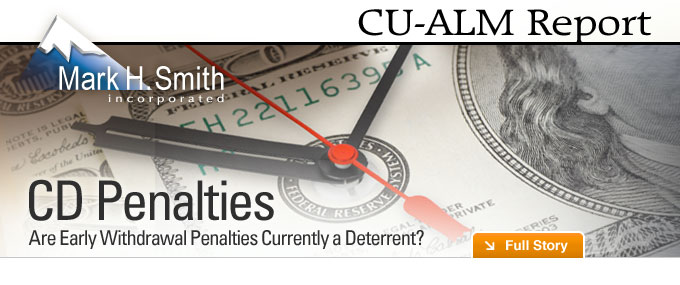By Jeff Johnson
 Early withdrawal penalties are designed to be a deterrent to members from withdrawing their certificates of deposit before the maturity date. In the current low interest rate environment, the penalties most credit unions impose may not act as the deterrent they were intended to be.
Early withdrawal penalties are designed to be a deterrent to members from withdrawing their certificates of deposit before the maturity date. In the current low interest rate environment, the penalties most credit unions impose may not act as the deterrent they were intended to be.
Early withdrawal of a CD usually happens when the early withdrawal penalty does not outweigh the benefit of reinvesting in a new CD with a higher rate, a member is not satisfied with earning a lower return on a CD as compared to other investment options, or an unforeseen circumstance arises and cash is needed. The risk associated with the first two reasons increases when rates are low, and can increase even more when rates stay low for a long period of time.
Click for the full article.





By Cynthia Walker, CEO
 "CU Savings Balances Top $1 Trillion" headlined a report from CUNA Mutual on May 18 of this year. Their report also indicated total credit union membership in the U.S. is estimated at 103 million, or 32.5% of the total population of the country.
"CU Savings Balances Top $1 Trillion" headlined a report from CUNA Mutual on May 18 of this year. Their report also indicated total credit union membership in the U.S. is estimated at 103 million, or 32.5% of the total population of the country.
With the June 2015 Call report data now available, I decided to do a little analysis and chart the trends and growth patterns of deposits along with the Federal Funds Rate and credit union cost of funds.
Click for the full article.





By Mark h. Smith, Inc. Staff
 Credit union managers are faced with a myriad of risk management decisions every day. These decisions have consequences, many of which can affect return on assets and the overall health and safety of the credit union.
Credit union managers are faced with a myriad of risk management decisions every day. These decisions have consequences, many of which can affect return on assets and the overall health and safety of the credit union.
When managers assess the many risk factors they also need to determine a course of action that is appropriate based on those assessments. The action can be steered by the answers to the following questions:
- What are the potential costs and benefits of the action?
- What is the potential magnitude of error if the outcome is not as expected?
- What is the risk or opportunity loss of doing nothing?
We should point out that doing nothing is often a valid consideration and can be the right choice at times. For example, during the last financial crisis, private label mortgage-backed securities were being pitched with much fervor as they offered nice returns and collateral values with little to no risk because they were forecasted to not go down. We now know in hindsight that choosing not to invest in many of these securities (i.e. do nothing in this space) may have suited us all better. Generally, when someone has said that an investment with a very healthy return and the collateral has no risk, a wise course of action is to turn and run. However, we digress.
Click for the full article.





|
Sept./Oct. 2015
View this email online.
Add MarkHSmith.com to your "safe sender" list.
|

